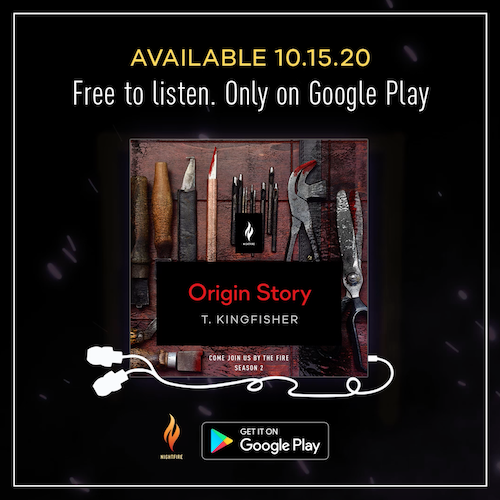sample heading
To celebrate the release of the second season of Come Join Us By The Fire, our audio horror anthology, we’ve asked authors with stories included in this year’s anthology to join us and write about horror. Below, T. Kingfisher (a.k.a. Ursula Vernon), whose story “Origin Story,” you can listen to here, writes about, well, the origin story of “Origin Story.”
“Origin Story” started with a joke on Twitter.
Many things in my life start with jokes on Twitter, which probably says something about my addiction to social media. I even sold a horror novel once by making a joke on Twitter.* This one, however, wasn’t even my joke originally.
My friend Jadzia Axelrod (an extraordinary talent in her own right) had written a blog post that included a number of fake fairy tales, including one called “The Good Sausage” about a woman giving birth to a heroic sausage who goes on to marry a princess. As I was known for my fairy tale retellings at the time, Jadzia tagged me in, saying that of course she wanted to see my take on “The Good Sausage.”
I tossed off a line in response:
“In the charnel house the last fairy worked, assembling children out of meat and bone, writing their names on the casings…”
It was a joke! It was one line! A line is not a story!
It didn’t stay one line for long. I had made the crucial mistake and interested myself.
If I am writing a novel, I usually have some idea what it’s about before I start. I may have absolutely no idea what the plot will be, but I start somewhere. “A woman falls in love with a magic sword.” “It’s a retelling of the Snow Queen, except screw that Kay kid, Gerta’s gonna run off with the bandit girl.” “A horror novel with a found manuscript, except the heroine is an editor and takes a red pen to it.” Something to get my teeth into.
A short story, though, usually starts with a line. Usually it’s the first line. Sometimes it’s a line somewhere in the middle. And as soon as I had written it, the last fairy in her charnel house sank her sewing needle into me and I had to know what she was doing.
I had no real idea where the story was going at first. I had images in my head that needed to fit somewhere, and once I started writing, other images popped up to go with them—flying things made out of skin and intestine, and the calf-eyed creature that could only sing and sigh. But once you have a couple things down on the page, the rest of the story starts to put itself together. What did the fairy’s co-workers think of her? I have worked with strange people, and sometimes I suspect I have been the strange person everyone else worked with, and this was a question worth answering. What did she think of the creatures that came in to be slaughtered? Was there ever one she wanted to save?

And whose story was it? The fairy was the center of the story, but I would be hard-pressed to call her a hero. She wasn’t a good fairy. She might be an evil fairy, depending on how you view sending creatures made out of hog intestine to flap around the rooftops of a slum, though I think probably she drew the line at a little light malice. Maybe. (What, you think I know everything there is to know about my characters? No, not at all. I know as much as I need to know, and frequently rather less.)
Could I have made her into a hero? Oh, maybe. I can think of a few scenarios now where I could coax her out of that slaughterhouse and onto an adventure, though she wouldn’t have enjoyed it. I still might someday. But there is a certain creative, obsessive sort of person that makes a poor protagonist. I am one myself. They do not so much reject a call to adventure as simply fail to notice it entirely. If Gandalf the Grey came to smoke a pipe on my doorstep, he would sit there for most of the day before I noticed, and then I would probably ask if the UPS guy had showed up yet, nod vaguely, and go back inside. It is difficult to go throw the Ring into Mt. Doom when you are still back in Bree, conducting an intensive survey of barrow-wight morphology.
Still, these are surmountable obstacles. The story didn’t have that shape in my head, though. Instead I found myself thinking about all the strange ways that a hero gets created in myths. In the story of Tatterhood, a wisewoman tells the queen to throw two seeds under her bed. They grow into flowers, and she is supposed to eat the beautiful flower, not the ugly one, but instead eats them both, and this somehow impregnates her with twins.
In a fairy tale, you just accept these things. Being me, I start asking questions like “Who is this weird horticulturalist who is knocking people up with flowers? Where did she get those seeds? Did she spend years in a greenhouse crossing species until she created this bizarre magical fertility hybrid?”
There is a truly marvelous Finnish story about a hero named Alderlog who is, in fact, a were-log. How did that happen? What kind of personality is roaming around randomly turning logs into babies? How do you start practicing that skill? Do you start small and turn bits of bark into mice, or is it more disturbing, and you’re turning twigs into random arms or eyeballs? Is there a fairy godmother wandering around leaving a trail of twitching body parts through the forest?
Come to think of it, when Zeus appeared to Danae as a shower of golden rain and she conceived Perseus, how did that even work? I will just barely accept a minotaur after the bit with the wooden cow, and at least everybody involved is a mammal, but rain?
These are the questions that keep me up at night, and which, if you try to discuss at the dinner table, lead to more questions, like “What is wrong with you?” and “Why are you like this?” And while you can start a story with a hero’s birth, a few thousand words about a fairy learning to actually bring the hero to life tends to get relegated to the prologue, and if you’re very unlucky, to italics.
But here was this story where I could really get my teeth into the learning curve of… well… how the heroic sausage gets made.**** I didn’t need to rush to get to the hero because I had no idea what the hero was going to do. Short stories have to be compact and focused compared to novels, but you can put that focus on nearly anything and the reader will go along for a few thousand words if you make it interesting, and if you don’t think that building people out of fetal calf skin and pig teeth is interesting, I’m not sure I can help you.
Of course there did, eventually, have to be the one great work. The training montage is no good without the scene where those skills get put to use. The draft horse woman also struck me as interesting. I’d like to find a story for her someday. She could definitely be a hero.
So that was “Origin Story”’s origin story. From a joke on Twitter to thinking far too much about fairy tales and heroic origins and meat processing. Sometimes you get these ideas, and like sinew threaded on a needle, you follow them to the knot at the end to see where they end up.
- *It was The Twisted Ones. I tweeted that my agent put up with a lot, including an elevator pitch that was “The Blair Witch Project meets the Andy Griffith Show.” Navah Wolfe was in my DMs five minutes later demanding to know if it was real, if it had sold, and if she could see it.**
- **This is a statistically unlikely occurrence and should not be taken as a roadmap for selling books by any prospective authors out there.***
- ***I am not allowed to use footnotes in my novels because I will abuse them.
- **This is a statistically unlikely occurrence and should not be taken as a roadmap for selling books by any prospective authors out there.***
- ****There was no way I wasn’t going to make this joke eventually.
T. Kingfisher, also known as Ursula Vernon, is the author and illustrator of many projects, including the horror novels The Hollow Places and The Twisted Ones, the webcomic “Digger,” which won the Hugo Award for Best Graphic Story and the Mythopoeic Award. Her novelette “The Tomato Thief” won the Hugo Award for Best Novelette, and her short story “Jackalope Wives” won the Nebula Award for Best Story. She is also the author of the bestselling Dragonbreath, and the Hamster Princess series of books for children. Find her online at RedWombatStudio.com.
Listen to her story “Origin Story” on Google Play here, and listen the the entirety of the second season of Come Join Us By The Fire here.



